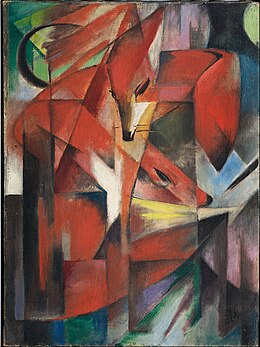The Foxes (Marc)
| The Foxes | |
|---|---|
 | |
| Artist | Franz Marc |
| Year | 1913 |
| Medium | oil on canvas |
| Dimensions | 88 cm × 66 cm (35 in × 26 in)[1] |
| Location | Private collection |
The Foxes (Template:Lang-de) is a 1913 painting by German painter Franz Marc. It was held by the Museum Kunstpalast in Düsseldorf[1] until returned to the heirs of Kurt Grawi in 2022, and sold at auction by them.[2]
Analysis
Prior to painting The Foxes in 1913, Marc was inspired by French Cubism and the Orphic works of Robert Delaunay. The Foxes reflects Marc's breakdown of the animals into abstract forms, presented in harmonized colors. The crystalline composition resembles stained glass windows in medieval churches.[1]
Provenance
Jewish investment banker Kurt Grawi purchased the painting in 1928.[3] Following the rise of Nazi Germany, Grawi was forced to sell much of his art collection and was incarcerated in Sachsenhausen concentration camp.[4] He was released after several weeks and escaped to Chile. Grawi still owned The Foxes, however, and sold the painting in 1940 to German-American film director William Dieterle. The painting was acquired by German businessman Helmut Horten in 1961,[3] and he donated it to the Düsseldorf city art collections in 1962.[1]
Restitution
In 2017, the heirs of Kurt Grawi made a restitution claim for the painting.[4] In 2021, the German advisory panel on Nazi-looted art urged the city of Düsseldorf to return the painting from the Museum Kunstpalast to the Grawi family. By then, the painting was valued between €15–€30 million.[3]
According to Der Spiegel, however, the city of Düsseldorf did not want to restitute the painting, and while promising its return, Düsseldorf was at the same time arguing that the sale had been voluntary and that the Grawis had been able to pay the special taxes levied on Jews by Nazis implying they still had resources.[5]
In January 2022, after months of "legal tug-of-war", Düsseldorf's Kunstpalast Museum restituted The Foxes to the Grawi heirs.[6] It was sold at an auction at Christie's for £42.6 million in March 2022.[7]
See also
References
- ^ a b c d "The Foxes". Google Arts & Culture. Retrieved April 19, 2021.
- ^ Fidler, Matt (31 January 2022). "A timber tiger and a lantern display: Monday's best photos". The Guardian.
- ^ a b c Hickley, Catherine (March 26, 2021). "German Nazi-looted art panel recommends return of Franz Marc's Foxes to heirs of Jewish banker". The Art Newspaper. Retrieved April 20, 2021.
- ^ a b Hickley, Catherine (December 19, 2017). "Düsseldorf faces Nazi-era claim for Franz Marc's foxes". The Art Newspaper. Retrieved April 20, 2021.
- ^ Knöfel, Ulrike (2021-09-28). "Umgang mit NS-Raubkunst in Düsseldorf: Rheinische Doppelzüngigkeit". Der Spiegel (in German). ISSN 2195-1349. Archived from the original on 2021-10-03. Retrieved 2022-01-19.
in solcher lag vor, weil Düsseldorf die Ansprüche der Erben Kurt Grawis für unangemessen hielt. Denn der Verkauf des Bildes sei sozusagen ein freiwilliger gewesen, so die Position am Rhein. Er sei über Mittelsleute in den USA getätigt worden, zu einer Zeit, als Grawi bereits nach Chile geflüchtet war. Außerdem erweckten die Rechtsberater der Stadt Düsseldorf der Eindruck, Grawi und seine etwas später emigrierte Frau seien seinerzeit nicht mittellos gewesen, sie hätten Zwangsabgaben wie die Judenvermögenssteuer und Reichsfluchtsteuer aufbringen können, weil sie eine Immobilie veräußert hätten.
- ^ "Stadt Düsseldorf gibt 14-Mio-Gemälde zurück an Erben". www.lootedart.com. Retrieved 2022-01-19.
The return was preceded by months of legal tug-of-war after the city council gave its approval at the end of April 2021 after years of dispute.
- ^ "The Recently Restituted Franz Marc's The Foxes Breaks the Artist's Record at Christie's". Widewalls. 4 March 2022. Retrieved 13 March 2022.
External links
 Media related to Die Füchse (Franz Marc) at Wikimedia Commons
Media related to Die Füchse (Franz Marc) at Wikimedia Commons
